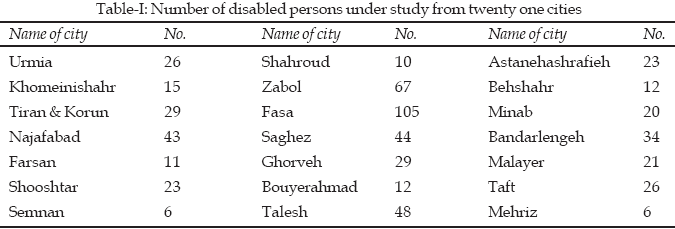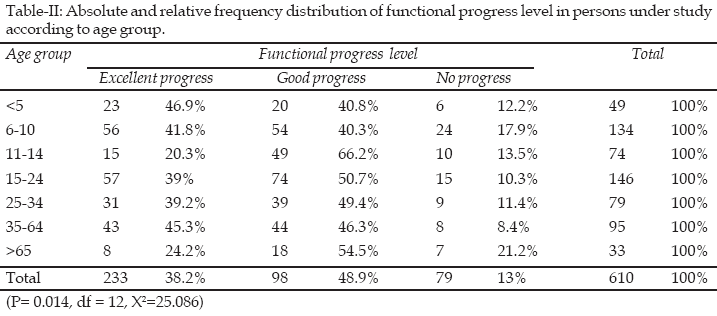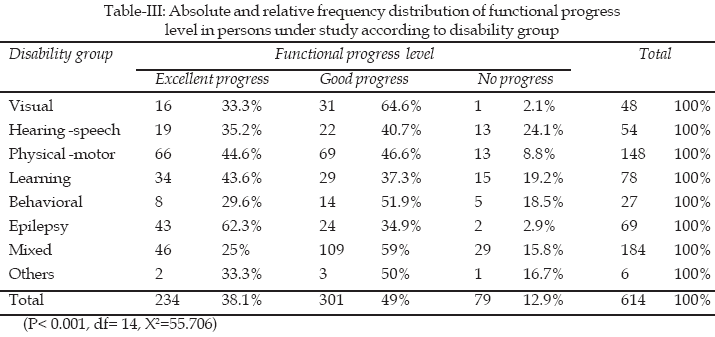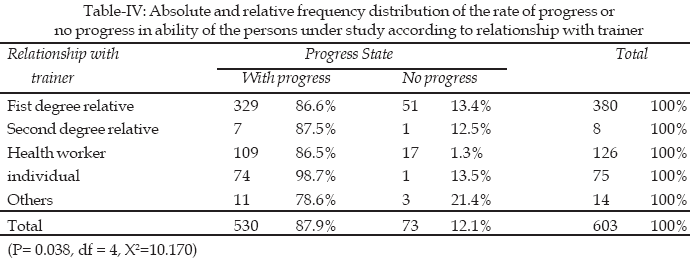|
 |
|
Published
by : PROFESSIONAL MEDICAL PUBLICATIONS |
|
ISSN 1681-715X |
|
|
|
|
|
- |
|
ORIGINAL
ARTICLE |
|
- |
|
Volume 25 |
April
- June 2009 (Part-II) |
Number 3 |
|
|
|
Home based training: Main strategy of
community based rehabilitation in Iran
Payman Salamati1, Farid Abolhassani2,
Batoul Shariati3,
Mohammad Kamali4, Seyed Mehdi Alehossein5
ABSTRACT
Objective: Study of effectiveness of "home based
training" in community based rehabilitation program on disabled people, who
were trained and evaluated at the end of the course, under supervision of 21
pilot health and medical networks.
Methodology: In a cross-sectional study, 614
disabled people who had participated in "home based training" were selected
with stratified random sampling method. They were evaluated according to
function progress level variables by community based rehabilitation program
experts. Age groups, sex, disability groups, employment state and teacher’s
relation variables were studied from their files and recording data.
Statistical analysis was performed with Chi-square test.
Results: There was a relationship between age group
and disability group with functional progress level (P value =0.014 & P value
<0.001). Low age groups, visual disabled group, epileptic patients and
individuals with learning disability had the best results. High age groups,
mixed age disability group and individuals with verbal and hearing problems
had the least favorable results. There was a relationship between teacher’s
relation with progress or no progress state (P value = 0.038). Individuals
that were teachers had the best results and individuals with teachers other
than first or second relation or health worker had the least favorable
results.
Conclusion: Home based training in community based
rehabilitation program is an effective method for improving the functions of
disabled people in some selected groups.
KEY WORDS: Community based rehabilitation, Community
health services, Home based training, Rehabilitation.
Pak J Med Sci April - June 2009 (Part-II)
Vol. 25 No. 3 462-467
How to cite this article:
Salamati P, Abolhassani F, Shariati B, Kamali M, Alehossein SM. Home based
training: main strategy of community based rehabilitation in Iran. Pak J Med
Sci 2009;25(3): 462-467.
1. Payman Salamati,
Associate Professor of Community Medicine,
2. Farid Abolhassani,
Assistant Professor of Internal Medicine,
3. Batoul Shariati,
Assistant Professor of Epidemiology,
University of British Columbia,
4. Mohammad Kamali,
Assistant Professor of Health Training,
Iran University of Medical Sciences,
5. Seyed Mehdi Alehossein,
Assistant professor of Radiology,
1,2,5: Tehran University of Medical Sciences,
Tehran – Iran.
Correspondence
Payman Salamati,
Bahrami Children’s Hospital,
Shahid Kiaee Street, Damavand Avenue,
Tehran, Iran.
E-mail: psalamati@tums.ac.ir
* Received for Publication: November 6, 2008
* Revision Received: December 11, 2008
* Revision Accepted: May 12, 2009
INTRODUCTION
World Health Organization estimates 7-10% of the general
population is disabled in the world, most of them in developing countries
where basic services are limited and they have no access to institutional
rehabilitation services. WHO developed community – based rehabilitation (CBR)
in response to the need to promote rehabilitation services for disabled people
in the late 1970s.
1,2
In 1994, a collaboration involving ILO, UNESCO and WHO
resulted in issuance of a "Joint Position Paper on CBR" to develop CBR
programs.
3
In 2004, ILO, UNESCO and WHO produced a revised Joint Position Paper defined
CBR as a strategy for rehabilitation, equalization of opportunities, poverty
reduction and social inclusion of people with disabilities.4
During the past two and a half decades CBR has been
implemented in many countries. While majority of medical personnel in Iran
have little information about recent developments in rehabilitation of
disabled people, CBR has been used in our country since 18 years ago and now
serving disabled people in 65 cities. It will be implemented all over the
country within the primary health care (PHC) referral frame work.
5
CBR is mainly based upon "home based training" (HBT)
program. For implementing HBT, Welfare Organization of Iran translated and
modified WHO guidelines through cultural differences and then published 34
Farsi booklets about seven major disabilities: visual, hearing- speech,
physical- motor, learning, behavioral, epilepsy and mixed.
5
Depending on the type of disability, the appropriate booklet was offered by
health workers to patients’ families. Health workers were also involved in
education and promotion of disabled people. They would select a member of
families of disabled person as a trainer and gave them WHO booklets about
related type of disability and involved them to provide effective
rehabilitation services. Trainers would take the responsibility of
rehabilitation under supervision of health workers.
In addition to HBT program, staff of CBR provides the
following services: diagnostic, therapeutic, educational, occupational,
learning and rehabilitation appliances.
In the present study, we evaluated the effectiveness of
"home based training program" of disabled persons and noted progress they had
in their abilities and some related factors.
METHODOLOGY
This cross sectional study is based upon rural disabled
population of 21 cities under surveillance of primary health care national
network, who had participated in HBT and their abilities were evaluated by CBR
supervisors. Proper education through booklet could improve disabled persons’
abilities. Supervisors of CBR classified the level of progress of patients in
three levels of useful, relatively useful and not useful after passing the
education course for each booklet. Provincial experts of CBR trained all CBR
supervisors about how to collect data and studied the trend of proper data
collection in each city. They periodically reported related data to national
CBR office.
For calculating functional progress level (F.P.L.), we used
mean of the points extracted from evaluation of WHO booklets as follows: point
of the evaluated manual as "non useful "was O, point of the "relative useful"
as 1 and "useful" was 2. Mean of the points with using this formula was:

The acquired F.P.L. was ordered as follows:
F.P.L.=O No progress
0< F.P.L.<1 good progress
1< F.P.L.<2 Excellent progress
Age, sex, type of disability, employment status and
trainer’s relation as independent variables and functional progress level as
dependent variable were considered. Confounding factors were financial
support, getting rehabilitation equipments, training outside of the family,
referral to upper levels and job opportunity.
By designing a pilot study and reviewing 30 selected
disabled persons, sample size was calculated about 600. Among 4103 disabled
people who had participated in HBT since the beginning of the plan and
appropriate to the size of 21 cities, stratified random sampling was
performed. Finally 614 persons were chosen using random numbers table as
simple randomization (Table-I). These patients had participated at training
courses for the last seven years since 1993. Statistical analysis was
performed with Chi-square test and logistic regression.

RESULTS
Six hundred fourteen (614) persons from 21 centers met the
inclusion criteria. There were 344 males (56%) and 270 females (44%). Three
hundreds and fifty four persons (57.7%) were in age groups of 6-24 years and
the rest were in other age groups. Age groups of four persons (0.7%) were
uncertain. Physical- motor was the most common disability as 148 cases (24.1%)
among disability groups. First degree relative was the most common trainer in
380 cases (61.9%) among trainer groups. Trainer groups of eleven persons
(1.8%) were uncertain. Of disabled people in age groups of 15-65 years, there
were 255 (84.8%) jobless and 46 (15.3%) had occupation.

Considering confounding factor of age, disabled people were
evaluated in the equal age groups. With using X
2
test, relations between independent and dependent variables were tested. There
was a relationship between age group and disability group with functional
progress level (P value = 0.014 & P value <0.001) (Tables-II & III). However,
the effects of other confounding factors were likely. Therefore, we tested
statistical relation of two concerned factors (age group and disability type
which showed relation with progression) to other likely confounding factors
(education outside of the family, education level, referral to upper levels,
receiving rehabilitation equipments, job opportunity and getting income) and
there weren’t any confounding role between above mentioned factors.

using logistic regression after changing dependent variable
into two groups, multivariate analysis did not show appropriate model. Then
functional progress level variable was changed to two states: non progress and
with progress states (with combining functional progress levels of good and
advanced progresses) and was evaluated with other variables (sex, age group,
disability group, employment state and trainer’s relation). there was a
relationship between trainer’s relation with progress or non progress state.
(P value= 0.038) (Table-IV).

DISCUSSION
Some studies have shown the effectiveness of CBR in
rehabilitation of disabled people.
6-8
On the other hand, some studies have doubted on it.9-10
May be, it has particular application to remote, rural and indigenous
communities11
where it is more cost- effective.12
It seems there is no real focus of research in CBR and the evidence based for
CBR is fragmented and incoherent on almost all aspects of CBR.10
In Iran, there were few studies about community based
rehabilitation. A local study about effectiveness of CBR in 14 provinces in
Iran in 2004 showed recent increased frequency of disabled persons with
physical - motor disabilities who were able to do independently their
activities and decreased number of totally dependent disabled persons.
13
Another study showed that HBT has positive effects only upon protective skills
of the family but not upon the independency skills of the disabled persons and
their families.14
In another study evaluating attitudes of rural families with handicapped
members, the authors showed there are more appropriate attitudes towards the
disability phenomenon where CBR plan has been executed.15
In yet another study evaluating different psychiatric rehabilitation nursing
models in the care of schizophrenic patients, the authors suggested multi-
dimensioned model as the best one because it is community based.16
In our study, about 49% of disabled people who participated
in the education course have achieved good progress level and 38.2% excellent
progress level. This reflects improving ability level of disabled people with
achievement of the program. The most participating age group was 15-24 years
with frequency of 23.8% and the least participating age group belonged to >65
years with frequency of 5.4% that showed active cooperation of the young
people and less cooperation of elders in the project.
In this study, age group of disabled people was related to
their progress (P value= 0.014). The most common frequency of "excellent
progress" was <5 years (46.91%). The majority of disabled people
belonged to age group of 6-10 years (41.8%) also had excellent progress during
educational course. These observations were probably due to the fact that
education at early childhood not only give better results but also could
prevent further complications of disability. The most common cause of "no
progress" was at age group of 65 years or more (21.2%). There were less people
in this group who achieved excellent progress level (24.2%). this matter was
probably related to the less effectiveness of educational courses at elderly
level with long standing disability.
type of disability of disabled people, was related to
functional progress level too (P value < 0.001). The best result was seen at
visual and epilepsy group. Disabled visual group had good or excellent
progress at 97.9% while only 2.1% had no progress after ending education
course. The most common frequency "excellent progress" was of epilepsy group
(62.3%) and only 2.9% of them had no progress in their abilities. Most of the
learning group (43.6%) also acquired excellent progress. Mixed disability
group had less success and only 25% achieving excellent progress. The most
common frequency of "loss of progression" belonged to the hearing- speech
disability group (24.1%).
Relationship of trainer with disabled persons was related
to progress state (P value= 0.038). First degree relatives of disabled people
had the most cooperation at learning them (61.9%). So if the disabled persons
were trainers of themselves (after acquiring enough education by health
workers), the most progress would be expected (98.7%). In case the trainer was
not first or second degree relative, or not health worker, the least progress
was expected (78.6%).
In conclusion, performing home based training of CBR
project is an effective way for improving the function of disabled people in
some selected groups. The following measures are suggested:
1. Introducing disabled people in lower age groups and
starting educational courses as soon as possible is very useful. Educational
courses for elderly disabled people can result in least benefits. Therefore,
considering the limited financial resources, it would be better using
educational services of CBR plan for younger age groups.
2. Disabled people in visual and learning groups and
epileptic persons have the best results when getting appropriate education.
This is important for decisions regarding trainers and allocation of
resources.
3. Proper selection of trainers could affect the progress
state of disabled persons. We suggest that if disabled persons are able to
be trainers of themselves, it’s the best way. otherwise, using trainers from
first or second degree relatives or health workers is preferable to the
others.
4. Optimization of evaluating system of disabled people
has good effects at level of their progress. Therefore, further studies are
recommended.
ACKNOWLEDGMENT
We wish to thank Mrs. Zohreh Jalili Tahmasebi for her kind
cooperation.
REFERENCES
1. Consultation to review community – based
rehabilitation. Geneva, World Health organization 2003;1-20.
2. Equal opportunities for all: promoting
community – based rehabilitation among urban poor populations. World Health
organization an Italian Association Amico di Raoul Follereau 2002;1-34.
3. CBR: A strategy for rehabilitation,
equalization of opportunities, poverty reduction and social inclusion of
people with disabilities: joint position paper / International Labour
organization, United Nations Educational, Scientific and Cultural organization
and the World Health organization 2004.
4. Report of the 4th Meeting on Development
of CBR Guidelines. Geneva, World Health Organization 2006;1-12.
5. Nahvinejad H. Performance of Community –
Based Rehabilitation (CBR) in Rural Areas of Islamic Republic of Iran. Iranian
Rehabilitation J 2004;1(1):1-19.
6. Powell J, Heslin J, Greenwood R.
Community based rehabilitation after sever traumatic brain injury a randomized
and controlled trial. J Neurology Neurosurgery & Psychiatry 2002;72:193-202.
7. Bellon ML, Rees RJ. The effect of context
on communication study of the language and communication skills of adults with
acquired brain injury. Brain Injury 2006;20(10):1069-78.
8. Pal DK. Social integration of children
with epilepsy in rural India. Social Science Medicine 2002;54(12):1867-74.
9. Rudd AG. Randomized controlled trial to
evaluate early discharge scheme for patients with stroke. BMJ
1997;315:1039-44.
10. Finkenflugel H, Wollfers I, Huijsman R.
The evidence base for community- based rehabilitation: a literature review.
International J Rehabilitation Research 2005;28:187-201.
11. kuipers P, Allen O. Preliminary
guidelines for the implementation of community based rehabilitation (CBR)
approaches in rural, remote and Indigenous communities in Australia. Rural and
Remote Health 4 (online), 2004;291. Available from http://www.rrh.org.au
12. Beech R. Economic consequences of early
inpatient discharge to community – based rehabilitation for stroke in an
inner-London teaching hospital. Stroke 1999;30:729-35.
13. kamali M. Community based rehabilitation
in Iran. University of Welfare and Rehabilitation Sci 2004;81-86:113-125.
[Farsi]
14. Hatamizadeh N. Effectiveness of home
based training service of community based rehabilitation program offered to
families of physically disabled people. J rehabilitation 2004;5(3):34-7.
[Farsi]
15. sattari B, Omidvar K H, yaghoobi V.
Measurement of attitude of rural families with handicapped members towards
handicapped in fields where community based rehabilitation has executed with
those who has not. J rehabilitation 2005;22(6):23-25. [Farsi]
16. Fallahi Khoshknab M. Design and evaluation of multi-
dimensional psychiatric rehabilitation nursing model in the care of
schizophrenic patients. J Shahid Sadoughi Uni Med Sci & Health Services
2002;3(10): 39- 46.
HOME
| SEARCH
| CURRENT
ISSUE | PAST
ISSUES
Professional
Medical Publications
Room No. 522, 5th Floor, Panorama Centre
Building No. 2, P.O. Box 8766, Saddar, Karachi - Pakistan.
Phones : 5688791, 5689285 Fax : 5689860
pjms@





